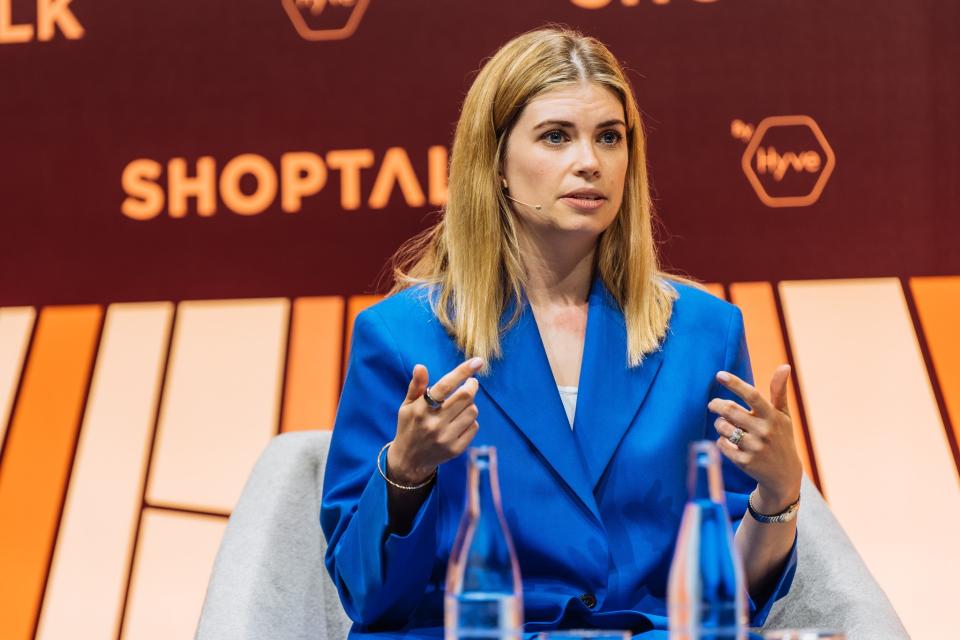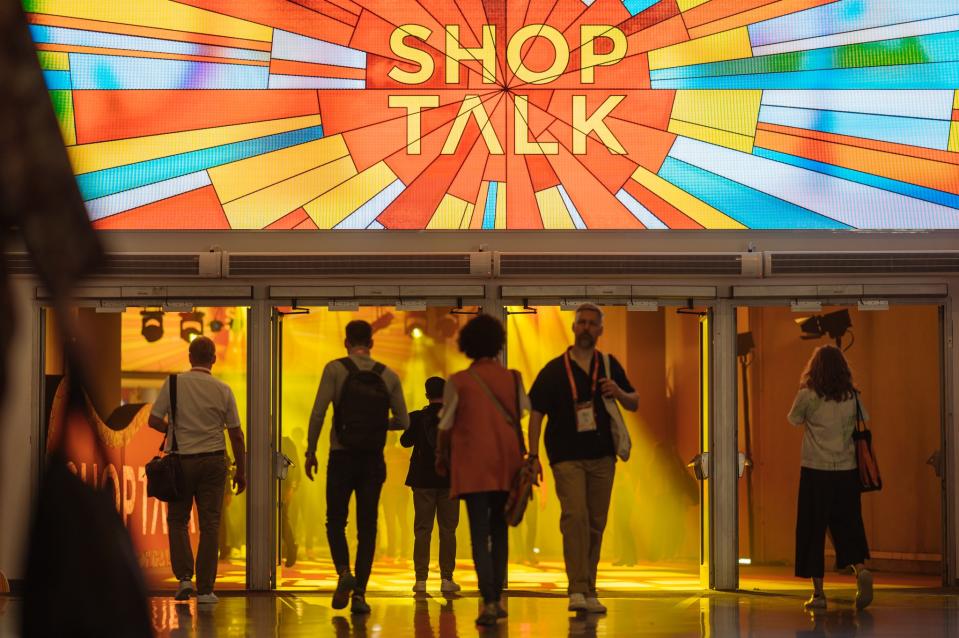Retailers Bet on Generative AI to Bring the Fun Into Online Shopping

BARCELONA, Spain — As rising interest rates and high inflation continue to weigh on consumer sentiment, online retailers gathered at the Shoptalk Europe retail conference in Barcelona were placing their hopes on the industry’s latest buzzword: generative AI.
Coinciding with Google’s announcement that it is testing artificial intelligence in search, the conference, which ran from May 9 to 11, heard how the transformative technology can help connect consumers with products in a more personalized and efficient manner. At the same time, attendees raised concerns about topics ranging from data privacy to the potential impact on jobs.
More from WWD
“Online retail is facing a seismic shift over the coming two years,” said Heikki Haldre, cofounder of AI deep tech company Miros.
Conventional search engines bring up just a fraction of relevant products, he said. Using the example of a search for a dirndl dress, he demonstrated how the Miros Wordless Search engine surfaces highly relevant fashion items in 60 seconds or less by recognizing browsing patterns based on which it mirrors the shopper’s buying intent.
“As I was doing those little scrolls here, the AI was doing almost one million queries back and forth with me,” he said. “It would be wrong of me to say it reads people’s minds, but it certainly feels like this.”
While Miros is still in the early stages of rollout, Haldre believes that in a context of depressed consumer spending, retailers that are quick to adopt generative AI into their platforms will have an advantage over those who don’t.
“Retailers at the moment are facing tough decisions. A normal procurement process is long — nine to 12 months for larger decision-makers — and now I don’t think they can afford to wait. Those who will wait, they will be left exponentially behind competitively,” he said.

Robert Gentz, cofounder and co-chief executive officer of German e-commerce platform Zalando, predicted that online shopping will change dramatically in the next 15 years.
“Fashion e-commerce is very efficient, it’s very easy, but it’s not yet 100 percent fun,” he said. “This is something that we have to drive to become better at, and I think there’s many innovations now, at a very fast pace, that are happening, that we want to embrace.”
The major advancement of generative AI is that it enables search engines to understand context, helping consumers to look for products for specific occasions. While Gentz cautioned that the technology is not yet mature, Zalando will soon launch a first beta version of a fashion assistant powered by ChatGPT across its app and web platforms.
The e-tailer registered a decrease of 0.1 percent in annual sales in 2022 as customers returned to physical stores in the post-pandemic period, deflating what had been euphoric growth for online players. Against that backdrop, Zalando is focusing on how to inspire and entertain its more than 50 million active customers, using every digital tool in the box.
“For example, 3D images help us to generate more engagement with consumers. We’re very convinced that a major way of how consumers will interact with us in the future is through short videos, so on the content side there’s a lot of things happening that actually will help to drive engagement and will make it much more fun,” Gentz said.
“And the advancements you see on generative AI, on machine learning, computer vision, I think all these advancements will actually help digital players to make the experience much more relevant, much more personal, and ultimately as well help us to reduce waste,” he added.
Data is key to generating personalized recommendations.
Stacia Carr, vice president size and fit at Zalando, said it will launch a new feature in June that allows customers using a Zalando app on a mobile device to generate their unique body measurements by taking just two pictures, one from the front and one from the side.
“We can then use that kind of data in the context of a virtual fitting room. Virtual fitting rooms have been kind of the holy grail for fashion e-commerce for a long time and we’ve really yet to see them scale,” she remarked.
The retailer partnered with Puma to test the function. “What we learned when we ran this pilot was not only were customers excited about being able to see how an item might fit their bodies, to really see themselves in our experience, but they also spent more time on this campaign,” she reported.
“Using data, tackling a really important customer problem, it’s not just about transaction conversion. It’s also about keeping customers engaged, building that relationship, helping them really get a feeling for what they might purchase,” Carr added.
With access to huge data sets, market leaders have a competitive advantage.
Google said its new generative AI shopping experience is built on its Shopping Graph, which has more than 35 billion product listings. “In fact, every hour, more than 1.8 billion listings are refreshed in our Shopping Graph to give people fresh, reliable results,” Elizabeth Reid, vice president of search at Google, said in a post last week.

Emma McFerrin, CEO of Lyst, has been using clustering, a machine learning technique, to analyze data from the shopping platform’s 200 million users in order to identify behavioral and taste groups. In particular, Lyst has homed in on the next generation of VICs, a highly knowledgeable and fragmented group that accounts for a growing share of luxury spending.
“There’s definitely a super luxury customer in the data who does not want to see fashion on sale. They only want to shop elite brands at full price,” she said. “Personalization has always been a big theme of what we do, but it will reach a point of hyper, hyper personalization — the expectations from that customer are so high.”
But retailers have to overcome several hurdles. Data privacy is front-of-mind since Italy’s temporary ban on ChatGPT highlighted concerns that new AI applications could breach the European Union’s stringent General Data Protection Regulation, so it’s key to ensure that consumers opt in.
“Where we really nail personalization is for our members, our registered users,” said McFerrin. “You want customers to consent to things that they’re going to get value from.”
Others fear the risk of reputational harm if ChatGPT and its emerging contemporaries present harmful misinformation, or automated systems run amok.
Alex Williams, head of online trading and growth at British retailer Marks & Spencer, detailed how it has developed an in-house capability dubbed Bullseye that allows it to tailor e-mails to users’ individual preferences. He estimated that M&S has 6 billion digital interactions with customers every year.
“Changing the operating model has been pretty challenging,” he said. “The idea of models running wild and the potential damage that that could do to your brand is something that really worried the brand teams, and so we’ve had to experiment our way through this and just take it step by step, exploring the boundaries, and then correcting based on that.”
It has also changed the role of managers at the 139-year-old retailer, by deferring power to tech teams. “This is pretty terrifying for a set of leaders who have actually not been used to that way of operating, when actually what this unlocks is removing what I call the insight loop, which is this loop that slows down the ability of an organization to respond to customer behavior,” he said.
“Not only do you respond to customers much more, but you also empower your teams massively and they enjoy the work they’re doing so much more,” Williams argued.

Yet others have questioned the impact of AI on jobs.
“You want to be responsible in the way you are studying the AI deployment. You want to ensure that there is a benefit for customers or employees,” said Stefano Perego, Amazon’s vice president of customer fulfilment and global operations services for North America and Europe.
Thanks to its “collaborative deployment” of AI, Amazon has hired more highly skilled workers in warehousing and logistics, and lowered workplace accidents by reducing the need for repetitive tasks, he said.
“You want to have some foundational tenets when you face a project in this space. Am I acting responsibly? Am I focusing on people and customer impact? Am I innovating with a thorough process that is focused on very clear requirements? I think if you do that, then I can see AI in the various declinations to be a force for good,” Perego said.
AI.Fashion, a digital fashion studio that creates photorealistic AI-generated fashion images, claims its technology helps brands reduce costs and limit waste. Yet CEO Daniel Citron was mindful of potential criticism, following the backlash that greeted the recent announcement by Levi’s that it would begin testing AI-generated clothing models.
“There’s a fear that I think is rightly placed that AI, not just in fashion and modeling, is going to have a pretty large economic impact, and I think part of that impact is going to be transitioning humans, and that’s something that we want to make sure does not have a large negative impact,” he said.
Going forward, the company plans to partner with models to convert their images into digital avatars, ensuring they receive a cut from any future use, though he could not say what proportion of its database would be based on humans. Citron expects the use of AI to spread to every area of the fashion industry, from design to manufacturing and marketing.
“We’ve even seen in the past couple of months, our technology has just gotten so, so much better and we think that pace is just going to continue to accelerate,” he said.

For ByondXR, which creates virtual and immersive online retail environments for brands including Shiseido, Lancôme, Estée Lauder and L’Oréal, AI has proved a godsend.
“If a client approaches us and we have to build a creative concept, before we had to really build it from scratch, even at the demo stage. It takes many hours of rendering and creative. Today, you can just write an initial concept or theoretical idea, and you can start getting images or 3D environments,” said strategic account executive Atay Schulberg. “In that aspect, it’s a big boost for us.”
In addition, the company is using AI tools to create talking avatars connected to ChatGPT that can be embedded in any website. “There’s a lot of customization, personalization, that’s going into place right now,” Schulberg said.
But for all the talk about innovation, executives emphasized that the customer comes first.
“We’re privileged enough to have a lot of data from our 160 million members,” said Sara Sjöberg, head of marketing and digital sales, South Europe, at Swedish high street giant Hennes & Mauritz. “They value convenience, they value simplicity, and then we can top off that with experience but we need to nail the basics first.”
She noted that retailers can get sidetracked in their quest to deliver the latest technology.
“We can all get creative and try to come up with fancy solutions or features or tech, but if we’re not solving a customer need, then we’re off. And I think we’ve fallen into that trap a couple of times,” she said. “But it’s really not rocket science. You need to go back to the basics and meeting the needs: how do you shop for products in the best way?”
Best of WWD

